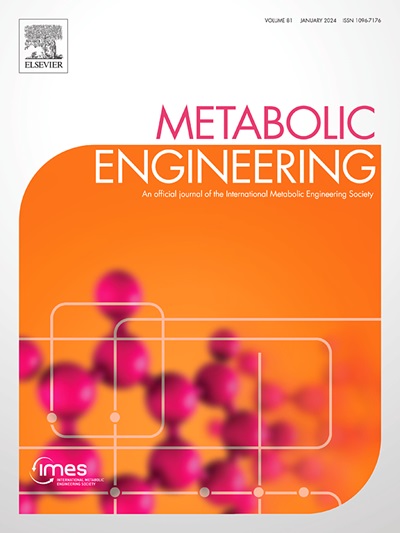Unraveling productivity-enhancing genes in Chinese hamster ovary cells via CRISPR activation screening using recombinase-mediated cassette exchange system
IF 6.8
1区 生物学
Q1 BIOTECHNOLOGY & APPLIED MICROBIOLOGY
引用次数: 0
Abstract
Chinese hamster ovary (CHO) cells, which are widely used for therapeutic protein production, have been genetically manipulated to enhance productivity. Nearly half of the genes in CHO cells are silenced, which are promising targets for CHO cell engineering. To identify novel gene targets among the silenced genes that can enhance productivity, we established a genome-wide clustered regularly interspaced short palindromic repeats activation (CRISPRa) screening platform for bispecific antibody (bsAb)-producing CHO (CHO-bsAb) cells with 110,979 guide RNAs (gRNAs) targeting 13,812 silenced genes using a virus-free recombinase-mediated cassette exchange-based gRNA integration method. Using this platform, we performed a fluorescence-activated cell sorting-based cold-capture assay to isolate cells with high fluorescence intensity, which is indicative of high specific bsAb productivity (qbsAb), and identified 90 significantly enriched genes. To verify the screening results, 14 high-scoring candidate genes were individually activated in CHO-bsAb cells via CRISPRa. Among these, 10 genes demonstrated enhanced fluorescence intensity of CHO-bsAb cells in the cold-capture assay when activated. Furthermore, the overexpression of the identified novel gene target Syce3 in CHO-bsAb cells resulted in a 1.4- to 1.9-fold increase in the maximum bsAb concentration, owing to improved qbsAb and specific growth rate. Thus, this virus-free CRISPRa screening platform is a potent tool for identifying novel engineering targets in CHO cells to improve bsAb production.
利用重组酶介导的盒式交换系统,通过 CRISPR 激活筛选揭示中国仓鼠卵巢细胞中的生产力增强基因。
中国仓鼠卵巢(CHO)细胞被广泛应用于治疗性蛋白质的生产,人们对其进行了基因改造,以提高其生产率。CHO 细胞中有近一半的基因处于沉默状态,这些基因是 CHO 细胞工程很有希望的靶点。为了从沉默基因中找出能提高生产率的新基因靶点,我们利用无病毒重组酶介导的基于盒交换的 gRNA 整合方法,为双特异性抗体(bsAb)生产的 CHO(CHO-bsAb)细胞建立了一个全基因组范围的聚类规则间隔短回文重复序列激活(CRISPRa)筛选平台,平台上有 110,979 个针对 13,812 个沉默基因的引导 RNA(gRNA)。利用这一平台,我们进行了基于荧光激活细胞分选的冷捕获检测,以分离出具有高荧光强度的细胞(这表明高特异性 bsAb 生产率(qbsAb)),并确定了 90 个显著富集的基因。为了验证筛选结果,通过 CRISPRa 在 CHO-bsAb 细胞中单独激活了 14 个高分候选基因。其中,10 个基因被激活后,CHO-bsAb 细胞在冷捕获实验中的荧光强度增强。此外,在CHO-bsAb细胞中过表达已确定的新基因靶点Syce3后,由于qbsAb和比生长率的提高,最大bsAb浓度增加了1.4至1.9倍。因此,这种无病毒 CRISPRa 筛选平台是在 CHO 细胞中鉴定新型工程靶点以提高 bsAb 产量的有效工具。
本文章由计算机程序翻译,如有差异,请以英文原文为准。
求助全文
约1分钟内获得全文
求助全文
来源期刊

Metabolic engineering
工程技术-生物工程与应用微生物
CiteScore
15.60
自引率
6.00%
发文量
140
审稿时长
44 days
期刊介绍:
Metabolic Engineering (MBE) is a journal that focuses on publishing original research papers on the directed modulation of metabolic pathways for metabolite overproduction or the enhancement of cellular properties. It welcomes papers that describe the engineering of native pathways and the synthesis of heterologous pathways to convert microorganisms into microbial cell factories. The journal covers experimental, computational, and modeling approaches for understanding metabolic pathways and manipulating them through genetic, media, or environmental means. Effective exploration of metabolic pathways necessitates the use of molecular biology and biochemistry methods, as well as engineering techniques for modeling and data analysis. MBE serves as a platform for interdisciplinary research in fields such as biochemistry, molecular biology, applied microbiology, cellular physiology, cellular nutrition in health and disease, and biochemical engineering. The journal publishes various types of papers, including original research papers and review papers. It is indexed and abstracted in databases such as Scopus, Embase, EMBiology, Current Contents - Life Sciences and Clinical Medicine, Science Citation Index, PubMed/Medline, CAS and Biotechnology Citation Index.
 求助内容:
求助内容: 应助结果提醒方式:
应助结果提醒方式:


